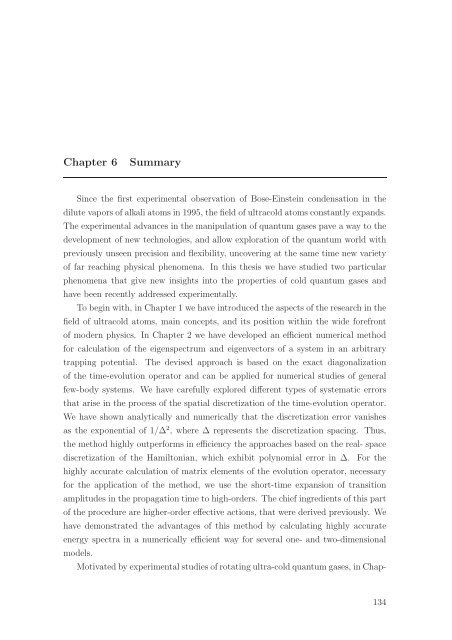PhD thesis in English
PhD thesis in English
PhD thesis in English
You also want an ePaper? Increase the reach of your titles
YUMPU automatically turns print PDFs into web optimized ePapers that Google loves.
Chapter 6SummaryS<strong>in</strong>ce the first experimental observation of Bose-E<strong>in</strong>ste<strong>in</strong> condensation <strong>in</strong> thedilute vapors of alkali atoms <strong>in</strong> 1995, the field of ultracold atoms constantly expands.The experimental advances <strong>in</strong> the manipulation of quantum gases pave a way to thedevelopment of new technologies, and allow exploration of the quantum world withpreviously unseen precision and flexibility, uncover<strong>in</strong>g at the same time new varietyof far reach<strong>in</strong>g physical phenomena. In this <strong>thesis</strong> we have studied two particularphenomena that give new <strong>in</strong>sights <strong>in</strong>to the properties of cold quantum gases andhave been recently addressed experimentally.To beg<strong>in</strong> with, <strong>in</strong> Chapter 1 we have <strong>in</strong>troduced the aspects of the research <strong>in</strong> thefield of ultracold atoms, ma<strong>in</strong> concepts, and its position with<strong>in</strong> the wide forefrontof modern physics. In Chapter 2 we have developed an efficient numerical methodfor calculation of the eigenspectrum and eigenvectors of a system <strong>in</strong> an arbitrarytrapp<strong>in</strong>g potential. The devised approach is based on the exact diagonalizationof the time-evolution operator and can be applied for numerical studies of generalfew-body systems. We have carefully explored different types of systematic errorsthat arise <strong>in</strong> the process of the spatial discretization of the time-evolution operator.We have shown analytically and numerically that the discretization error vanishesas the exponential of 1/∆ 2 , where ∆ represents the discretization spac<strong>in</strong>g. Thus,the method highly outperforms <strong>in</strong> efficiency the approaches based on the real- spacediscretization of the Hamiltonian, which exhibit polynomial error <strong>in</strong> ∆. For thehighly accurate calculation of matrix elements of the evolution operator, necessaryfor the application of the method, we use the short-time expansion of transitionamplitudes <strong>in</strong> the propagation time to high-orders. The chief <strong>in</strong>gredients of this partof the procedure are higher-order effective actions, that were derived previously. Wehave demonstrated the advantages of this method by calculat<strong>in</strong>g highly accurateenergy spectra <strong>in</strong> a numerically efficient way for several one- and two-dimensionalmodels.Motivated by experimental studies of rotat<strong>in</strong>g ultra-cold quantum gases, <strong>in</strong> Chap-134
















